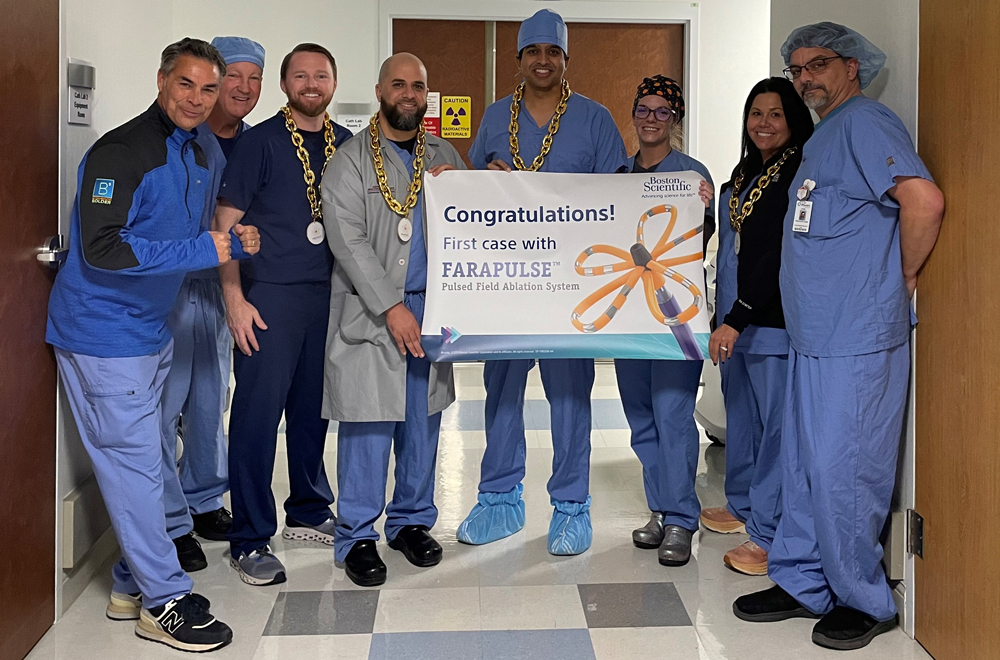
Pathway to heart health
TransCarotid artery revascularization offers clinically proven treatment for cardiovascular ailment
Kathy Warner was going about her busy day when she suddenly lost sight in her right eye. Since she has a history of migraines, she didn’t think much of it until she awoke the next morning and still couldn’t see. That’s when her husband drove her to the Emergency Department at St. Mary Medical Center in Hobart.
Warner soon discovered she had suffered an ocular stroke. While her vision returned, the underlying problem remained – carotid artery disease.
People often dismiss the “vascular” part of cardiovascular services, said Interventional Cardiologist Kais Yehyawi, MD, who is affiliated with Community Healthcare System.
“The carotid artery carries blood to the most vital organ – the brain,” he said. “The vascular system is most affected by atherosclerosis – the buildup of plaque in the arteries. When that happens, it often leads to carotid artery stenosis, which is responsible for a transient ischemic attack (TIA), or stroke.”
A carotid angiogram showed Warner had a 755 blockage in her right internal carotid artery. If left untreated, this buildup could have slowed blood flow or dislodged and traveled through the artery to the brain, causing a potentially disabling stroke.
Every year, 15 million people worldwide suffer a stroke, with 6 million dying and another 5 million left permanently disabled, according to the World Health Organization. Carotid artery disease is the cause of stroke in up to one-third of cases.
TCAR is clinically proven to be a safer procedure for high-risk surgical patients. Traditional treatment options, such as carotid endarterectomy (CEA, an open surgery) or carotid artery stenting, have been shown to treat the blockage effectively. However, both options have limitations and carry a risk of stroke during the procedures themselves.
Community Healthcare System’s cardiovascular team reviews patient profiles during multi-disciplinary meetings to carefully consider each person’s case and potential risks.
It was determined that Warner was a good candidate for a new minimally invasive procedure – transcarotid artery revascularization (TCAR). St. Mary Medical Center was among the first hospitals in Indiana to offer TCAR to treat carotid artery disease and prevent future strokes.
“We’ve been extremely successful in helping patients who have symptoms like the ones Kathy experienced,” Yehyawi said.
TCAR is a clinically proven treatment that uses temporary blood flow reversal during direct transcarotid stent placement. This treatment option provides best-in-class neuroprotection in a more-efficient and less-invasive approach compared to traditional carotid endarterectomy.
The Centers for Disease Control and Prevention say 80% of strokes are preventable.
“The key is understanding who is at risk,” Yehyawi said. “Usually we look at the traditional risk factors, including diabetes, high cholesterol and family history. However, there’s more to consider. People who are depressed, have a higher stress level and are anxious are at an increased risk.”
“It represents the modernization of carotid repair,” he said. “Our patients recover quickly with less pain, and the risk of complications is significantly decreased.”
Warner has a history of valve replacement and underwent two open heart surgeries within six years. She recently celebrated her 64th birthday and is thankful for her quick recovery from the TCAR procedure.
“It’s amazing how fast it was,” she said. “Compared to how they used to do this surgery, I’m sure this is a homerun.”
Like CEA, TCAR involves direct access to the carotid artery, but through a much smaller incision just above the clavicle instead of a longer incision along the entire neck – creating enough room to place a stent directly into the carotid artery to stabilize the blockage and help prevent future strokes. This minimally invasive procedure is unique in that blood flow is temporarily reversed so any plaque debris that may break off is diverted away from the brain, preventing a stroke from happening.
“This procedure is groundbreaking in the fight against stroke,” Yehyawi said.

